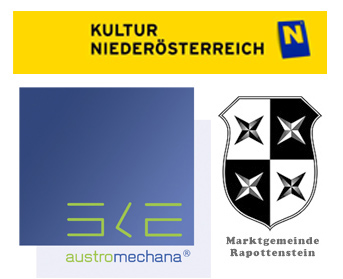Master Courses 2012
Artistic Direction & Lessons:
Günther Rabl
Technical Direction & Lessons: Wolfgang
Musil
Artists in Residence: Chiko
Mori, Oliver Grimm (Tokyo)
Organisation: Aron Saringer
Supported by: Land Niederösterreich, SKE-Fond, Gemeinde Rappottenstein,
Sparkasse Waldviertel-Mitte
July 11-18, 2012
Altes Sägewerk, Heumühle, Rappottenstein, Austria
Participants:
Martin von Allmen (CH), Richard Bruzek (A), Klaus Gstettner (A), Florian
Hollerweger (A), Daniel Lercher (A), Thomas Mayr (A), Vinzenz Schwab (A)
Special Guest: Limpe
Fuchs
Topics
In instrumental music we find a historically-developed division of labor
encompassing various areas from instrument building, to composition, to
the interpretation by musicians, orchestras and conductors. Just how these
areas communicate and intertwine is differently regulated in the diverse
stylistic variations of playing instrumental music. Only one thing applies
to them all: Sound generation is the last link in the production chain.
No matter whether it is composed or improvised music; whether it is classical
music, folk music or jazz – in the end, the musicians have to transpose
the musical idea into a hearable sound.
In electroacoustics, a totally different path was opened from the start.
The relationship of composition and sound generation is inverted thereby.
The sound is not the end result of the interpretation of a composition,
of a plan; the sound stands at the beginning, it is the point of departure:
material. Thus, the creation of music itself is radically altered. The
work on the concrete material is more like an integral craft than an architectonic
planning. Even if the result is definitively music, the technique of creation
more closely approaches a type of visual art than a composition in the
traditional sense. The sound of traditional music instruments also shows
itself in a different light when it is applied as material. Sound allows
itself to not only be used as artistic material as soon as it has been
transformed into the electronic medium. Data which is decisive for further
processing and composition can be extracted with analytical methods from
any material. That extends from the interpretation of analytical data
as series for arbitrary parameters to the construction of singular, individual
tonal systems for working with a certain sound type.
-
Small Fish
photos/workshop2012_16.jpg
-
Workshop Compilation Event
photos/workshop12_1.jpgWorkshop

-
Sea Turtle
photos/workshop12_2.jpgWorkshop

-
Red Coral
photos/workshop12_3.jpgWorkshop

-
Coral Reef
photos/workshop12_4.jpgWorkshop

-
Blue Fish
photos/workshop12_5.jpgWorkshop

-
TinySlideshow v.2
photos/workshop12_6.jpgWorkshop

-
Squid
photos/workshop12_7.jpgWorkshop

-
Small Fish
photos/workshop12_8.jpg
-
Small Fish
photos/workshop12_9.jpg
-
Small Fish
photos/workshop12_10.jpg
-
Small Fish
photos/workshop12_11.jpg
-
Small Fish
photos/workshop12_12.jpg
-
Small Fish
photos/workshop12_13.jpg
-
Small Fish
photos/workshop12_14.jpg
-
Small Fish
photos/workshop12_15.jpg

